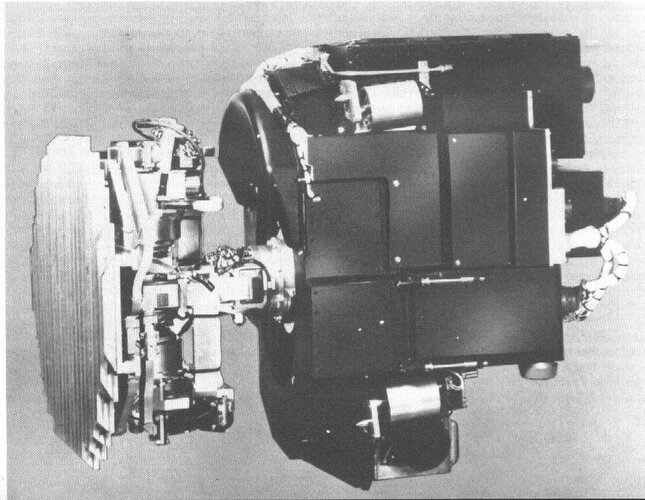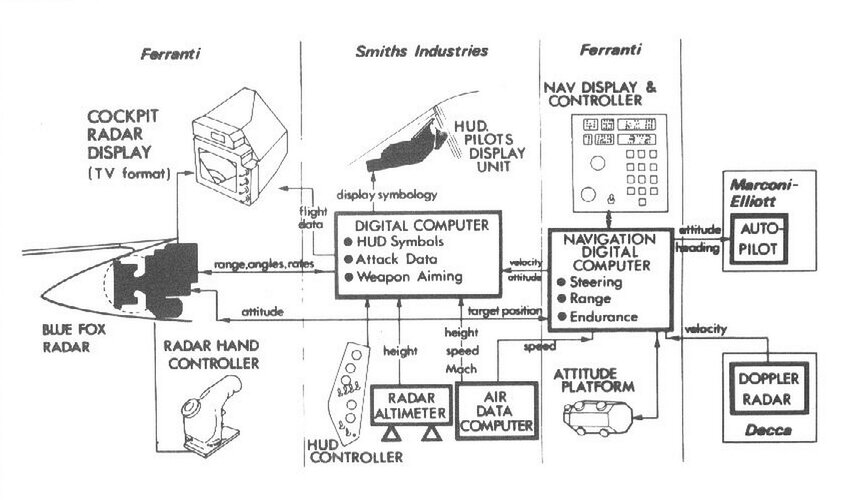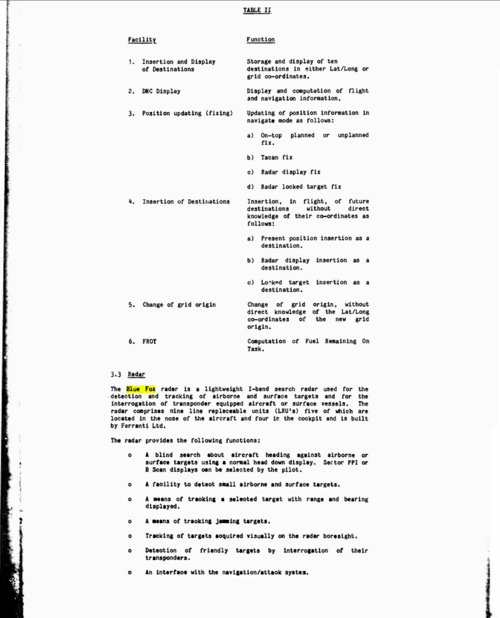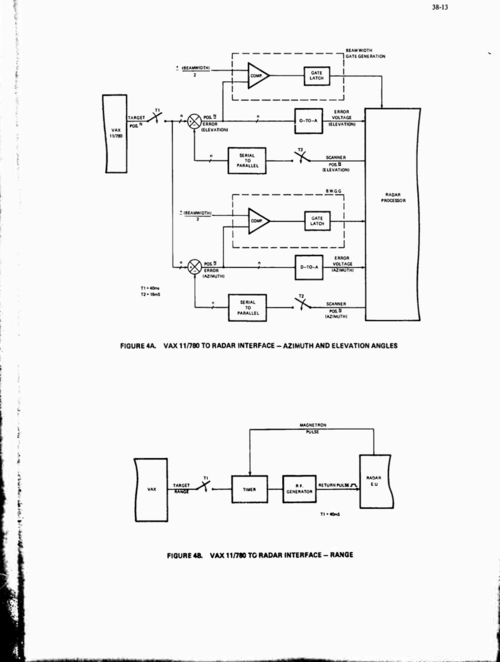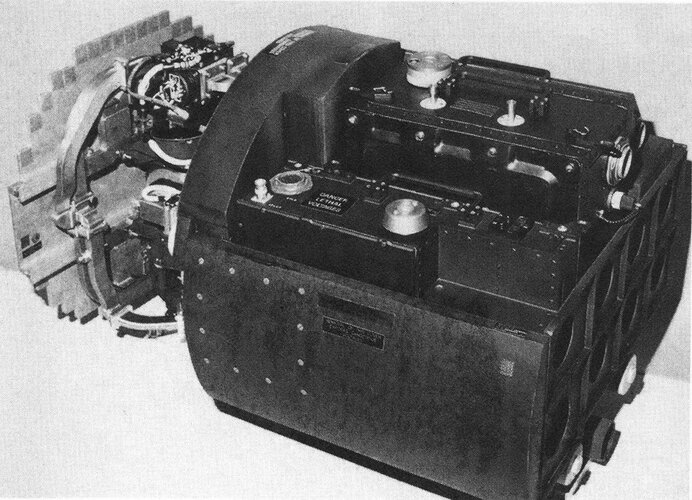- Joined
- 27 December 2005
- Messages
- 17,450
- Reaction score
- 24,401
Blue Fox interception radar
Blue Fox is a lightweight (less than 190 lb, 86 kg), high-performance, pulse-modulated non-coherent radar that combines airborne interception and air-to-surface search and strike for the Sea Harriers of the British Royal Navy and Indian Navy. The specific roles are:
The main radar unit is housed within the folding nose of the aircraft and comprises five line-replaceable units: the transmitter, receiver, processor, amplifier electronic control, and scanner. The remaining four units within the cockpit are also first-line replaceable. The display which makes up two of them is divided between the actual presentation and its associated drive unit. Of the other two units, the radar control set contains those controls which can be preset before an attack and the hand controller contains those that may need to be operated during an attack. The radar has a flat aperture, slotted array antenna which provides better detection ranges than more conventional forms; it also reduces sidelobes, another benefit in an electronic countermeasures (ECM) environment.
- Search, in which there is a choice of scan patterns in azimuth and elevation for use against air-to-air and air-to-surface targets.
- Detection. in which the radar embodies special features to facilitate detection of small air and surface targets.
- Lock-on track, to provide the input to the weapon aiming computer for weapon release.
- Radar lock-on visual acquisition, where the pilot flies the aiming mark on the head-up display onto either air or surface targets and then locks the radar onto the target by pressing the 'accept' button.
- Air-to-surface ranging, where during an attack the radar boresight can be slaved continuously to the aiming mark to provide ranging irrespective of whether or not the surface target is radar discrete.
- Identification, in which transponder returns from friendly ships and aircraft are displayed for identification and location.
- Visual identification, where the radar incorporates a short-range scale to enable the Sea Harrier to close to within a short distance so that the pilot can identify visually any intruder aircraft.
- Navigation, in which the radar can be used in a ground-mapping role as well as interfacing with the navigation computer.
It is roll-stabiIised to provide increased accuracy during air-to-surface attacks. Source of the RF energy is a magnetron. Within the processor unit is a digital scan-converter which increases the brightness of the display in all conditions of ambient lighting, even when the sun is shining directly onto the face of the display; its storage and variable persistence can be used to advantage elsewhere. By selecting a 'freeze' facility the radar picture can be retained indefinitely after the transmitter has been switched off, a useful capability in an ECM environment when approaching a potential surface target for subsequent attack.
Alternatively, a 'tails' selection can be made which will cause moving targets to produce a comet-tail effect on the display and thus indicate relative track histories in an air-to-air encounter. The system is frequency-agile, ie within a wide frequency band each pulse is transmitted on a different frequency from the previous one, the rate of change of frequency being very rapid.
This technique results in several advantages: Effects of sea and rain clutter are reduced and the system's detection capability under these conditions increases. It combats the effect of ECM since the enemy is forced to jam over a wider frequency band, decreasing its effectiveness.
It counters the effect of glint. When the radar target with a complex reflecting surface such as a naval vessel carrying radar and radio antennas changes aspect relative to a radar transmitter, the effective radar centre of the target changes; it can even move to a point outside the physical outline of the target. The effect on the radar tracking target is to introduce low frequency noise into the tracking loop as the radar attempts to follow the rapidly shifting centre of reflection. Using the frequency-agile mode, this glinting action takes place much more quickly so that in a short time it is possible to determine a sharply defined average position of the target. The elimination of glint is important for missile guidance systems.
Frequency agility eliminates the confusing effects of second trace returns; these are return echoes from large targets outside the range scale that appear on the display in random fashion. This advantage is particularly evident when operating near coast lines or other features having large radar echoes.
as a naval vessel carrying radar and radio antennas changes aspect relative to a radar transmitter, the effective radar centre of the target changes; it can even move to a point outside the physical outline of the target. The effect on the radar tracking target is to introduce low frequency noise into the tracking loop as the radar attempts to follow the rapidly shifting centre of reflection. Using the frequency-agile mode, this glinting action takes place much more quickly so that in a short time it is possible to determine a sharply defined average position of the target. The elimination of glint is important for missile guidance systems.
Frequency agility eliminates the confusing effects of second trace returns; these are return echoes from large targets outside the range scale that appear on the display in random fashion. This advantage is particularly evident when operating near coast lines or other features having large radar echoes.
STATUS: in production for British Aerospace Sea Harrier.
Red Fox radar
Electronically identical to the Blue Fox radar in the Sea Harriers (see previous entry), Red Fox has been repackaged to suit other aircraft types with a different nose profile. This lightweight, I band pulse-modulated radar is designed for airborne interception and air-to-surface search and attack, with an overland capability. Potential applications include the retrofit of Soviet-designed radars in MiG-21 fighters.
Jane's Avionics 1987-1988
Last edited:

